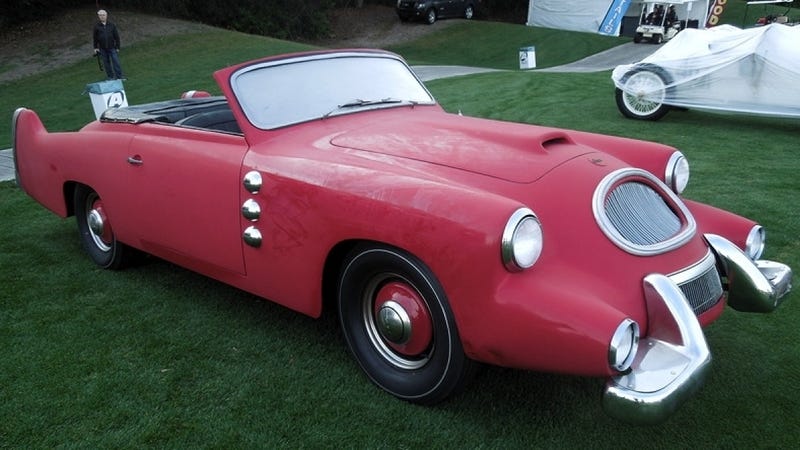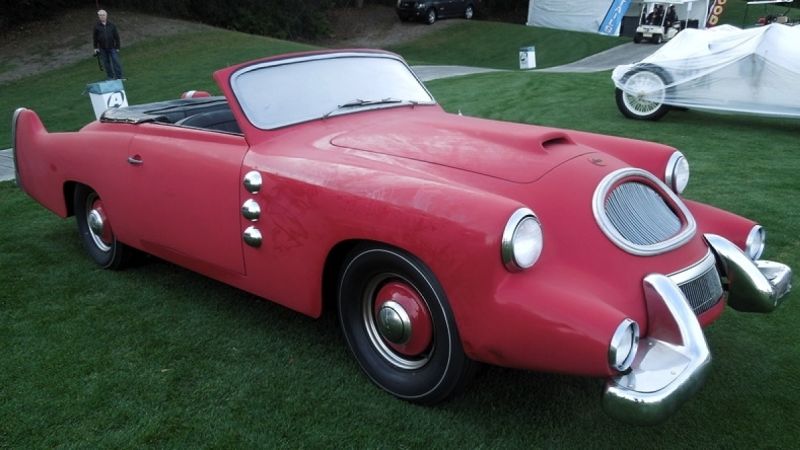
There’s something bittersweet about looking at the last car an automotive manufacturer put together. Behind all those metal curves and hopefully-this-sticks innovations, you can almost see the vain hope that this will rejuvenate the company, that this will be the thing that manages to bring them back from the brink of destruction. It’s something you can definitely see lingering in the bodywork of the 1958 Spohn DV-13 convertible.
Spohn Coachworks was a German company founded in the early 20s. While Hermann Spohn didn’t live to see the company take off, he was the mastermind behind their unique designs and their decision that, rather than focusing entirely on building cars from scratch, they could make something as equally beautiful with chassis already available to them.
With chief body designer and engineer Josef Eiwanger at the helm, Spohn really took off in the 1930s. Their appeal was in their difference. The post-war trends of grill-changing and lowering established by American customizers was in vogue—but that was a little too vulgar for Eiwanger. He opted instead for thick fenders, big fins, and sharply sloped front ends.
They were unique and, most importantly, eye-catching designs. Before long, Bugatti, Mercedes-Benz, and Maybach chassis were all lining up to work with Spohn, trading chassis for beautiful coaches. Hell, Spohn were responsible for some of Maybach’s most well-known models, the Zeppelin DS8 and SW38. Spohn introduced streamlined bodies long before the Pierce-Arrow was unveiling the Silver Arrow.
While many automakers suffered in the wake of WWII, Spohn actually found ways to continue building and thriving during and after. Eiwanger retired, putting his son, Josef Eiwanger Jr in charge. Before long, the occupying French were putting Spohn to task repairing military vehicles. After the war and the West German currency reform, Spohn found a surprising market: America.
Advertisement
See, American GIs stationed in Europe had seen the appeal of the sleek European makes as opposed to bulkier American cars. Soon, they were lining up at the door asking Spohn to create custom bodies for their cars, since the U.S. military was shipping cars back for free. It turned out to be an incredible marketing opportunity, one where Spohn found a surprising amount of success.
But once the Americans cleared out, that was it. Eiwanger Jr. had been in talks with the Americans, hoping to cobble together a full-time opportunity making and selling cars in America. This wasn’t to be. The GIs who had purchased custom coaches from Spohn returned home, and no one was particularly eager to start inviting a German company to take up residence in an America vitalized by a sense of postwar unity and patriotism.
Spohn closed up shop permanently in 1957 after producing a few concept cars for the Paris motor show. All their assets were liquidated.
Advertisement
But their last attempt was the D-13 convertible—or, so we believe. There aren’t a ton of records of this car, since it seemed to be a last ditch effort to convince folks that Spohn could (and should) have a relevant future in the future of the German automotive industry.
This particular vehicle was built on a 1939 Ford chassis with a ‘53 Cadillac 331 cubic-inch V8 engine, matched with a 3-speed Ford transmission. It’s pretty easy to see that this bad boy was designed with the American buyer in mind.
It’s just… ouch. At first glance, the DV-13 reminded me a little bit of Erwin Wurm’s Fat Cars. This bad boy is not really sleek or subtle in any way. It is very long and curvy, but more in a “ate too much Halloween candy” way as opposed to a Marilyn Monroe way. Its two grills and two sets of headlights (the bottom row jutting out farther than the top) just make it look like the designers got confused and were trying to do far too much to make this car appeal to the audience.
Advertisement
Yes, it is a decently revolutionary design—just, not in the good way. This is a car that, unfortunately, just didn’t find a niche anywhere. It was Spohn’s last attempt at doing something daring, and it fell flat.
The car still makes its rounds at car shows and the occasional auction, since it is a rarity—only one car like this one exists, and it’s only one of about 200 made by Spohn. But… it’s also an ugly duckling. It’s pretty unfortunately easy to see why Spohn couldn’t make anything out of this one.













